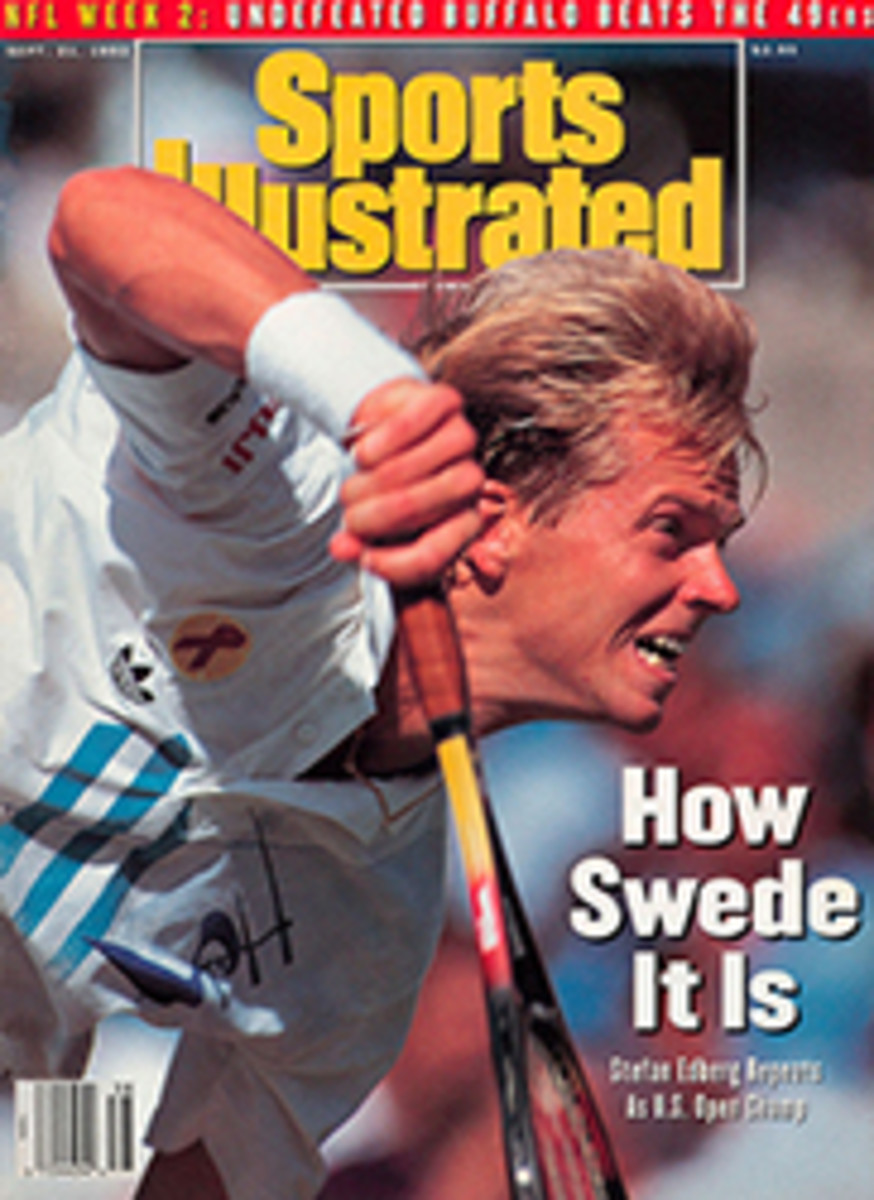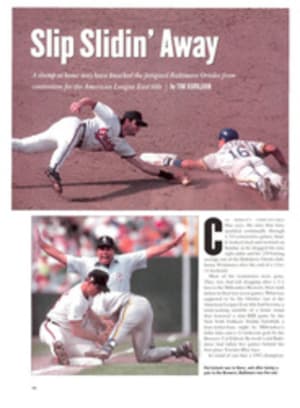
All Pumped Up
In support of the notion that human beings will somehow find a way to compete at anything, we present Exhibit A: handcar racing. First, a little background: The handcar was invented in the 19th century as a vehicle to transport railroad workers and their equipment along the tracks. Basically, it's a platform with train wheels that's propelled by a direct-drive mechanism. The workers would pump a double-handled lever bar that turned a large gear linked to a smaller gear on one of the axles, moving the car forward. By the 1940s the handcar had become largely extinct. Now this relic of railroading's past has been resurrected—not for use on the rails but for racing.
O.K., so it will probably never be an Olympic event, but don't tell that to the more than 500 devotees who will gather in Sacramento this weekend for the 10th annual U.S. National Handcar Races. If you're serious about pain, then this is the sport for you.
"It requires strength, speed, blood-and-guts endurance, primordial screaming and teamwork," says Kurt Armstrong of Lake Oswego, Ore., a 37-year-old sports massage therapist who has been racing handcars since 1985 and whose Gold's Gym of Portland team took second place in the open heavyweight category last year. "Every stroke—up and down—is as hard and painful as you can make it."
A handcar racing team consists of five members—a pusher and four pumpers. With the pumpers standing on the stationary car, the pusher squats behind it and pushes to get it going. The pumpers then drive the car by working the lever bar. Each race is a furious, punishing 300-meter run against the clock.
The nationals are the brainchild of Bill Timmons, 47, a guide at the California State Railroad Museum in Sacramento. "In May 1981 we had a rail fair in conjunction with the opening of the museum," says Timmons, "and train buffs came from all over the world. We had an old handcar that we gave rides on, and a fellow from Port Moody, British Columbia, mentioned that they held the world handcar championships up there every year in July. So just for kicks I took a team that summer. Our pusher was 61."
The field for the '81 world championships was made up of some 50 Canadian teams. Convinced that the U.S. could hold its own on the international level, Timmons put together a more competitive team the following year and finished in second place.
By then he was determined to build a better mousetrap. The railroad museum's restoration shop constructed two handcars, custom-designed for safety and durability, and twice as heavy as the 400-pound originals. In May '83, on the site of the terminus of the western end of the first transcontinental railroad, the U.S. National Handcar Races were born.
From its casual, just-for-fun beginning, the event evolved into an intense competition, as bodybuilders and weightlifters were drawn in. Handcar racing has now reached the point where people are studying videotapes to evaluate subtleties of technique.
There are two fundamental elements of pumping. At the start pumpers apply back and leg strength to the lever—being careful, however, not to apply too much force initially, which would cause the wheels to spin. Then, as the handcar reaches top speed, about 26 miles per hour, the pumpers crouch down as low as they can to decrease wind resistance, driving the bar from shoulder level and using only their upper-body strength. At that point arm speed becomes crucial. Because of the direct drive of the vehicle, each stroke has to be as fast and forceful as possible or the car will slow down.
Endurance and teamwork are essential. "The last 150 meters of the track is intensely cardiovascular," says 49-year-old Nancy Halverstadt, a 10-year veteran, whose Handcar Whiz Kids of Sacramento set a masters mixed (men and women) record with a 36.721-second qualifying heat last year and won the gold medal in the finals. "If you don't have persistence, you die real quick. You hit a wall of pain, and you have to pull through it and keep going. You better not look up for the finish line, because if you do, you catch the wind. Besides, if you're on the front of the car, it's a little scary to look up."
As the sport becomes more competitive, microseconds make the difference. "In 1985 the difference between first and second was actually .001 of a second," says College of San Mateo track coach and official handcar timer Bob Rush, who also works as a timer for San Francisco's famed Bay to Breakers road race.
Last year 105 teams, including representatives from Utah, Nevada and British Columbia, competed in the nationals, held over three days in September. About one third of the entries were first-timers. Among the more serious newcomers were the Wood Brothers, a team of seven siblings who gathered from seven far-flung states, and the Wacky Rollers, whose 40-year-old captain and pusher, Bob Freeman from San Jose, prepared for the competition by shoving a Cadillac around his body shop. The majority of the casual entries were eliminated in the time trials on the first two days. On the first evening, a Friday, a stiff breeze blowing from the south gave the contestants a tail-wind, and times were fast. Just Us Five, a team of California Justice Department employees, set a men's masters record of 33.392 seconds.
On Day 2, with the temperature in the high 90's, the air was dead and times were slower, but there were still a few surprises. One of the biggest was the Davis (Calif.) Time for Travel outfit, a rookie entry in the mixed-novice category. When the Davis pumpers stepped onto the car for their mandatory practice run, they were facing in the wrong direction, and race officials had to turn them around. Nevertheless, after one practice run they recorded the third-best time in their category.
The hot weather helped the pushers, who, in a separate event, shove a handcar for distance. Helped by the blistering heat, which favorably affected the rails and the car's greased bearings, seven men in the superheavyweight, heavyweight, middleweight and masters categories eclipsed the record of 224'10". The mightiest push (238'11½") was turned in by Team Trauma's Randy Harries, a 5'10", 308-pound powerlifter from Sacramento, who was ranked second in the nation in the superheavyweight bench press by the American Drug-Free Powerlifting Association, an organization that rigorously tests its competitors for steroids. The Wood Brothers did not survive the cut in the open novice category, but David Wood made the men's middleweight pushers finals with 211'1‚Äö√Ñ√∂‚àö√±‚àö¬™".
Sunday, the day of the finals, promised to be another scorcher, and by 10 a.m., the race site looked like a scene from Muscle Beach. The 500-seat grandstand was filled with competitors, their families and friends. The competition began with the pushers' contest at 11 a.m., but the anticipated battle of titans never materialized: The steel rails and greased bearings were still cold, and the handcars did not roll well. Pushes were much shorter—as much as 80 feet shorter—than those of the previous day. Wood's 129'3" was only good enough for fourth in his division.
Floyd Layher, a 6'8", 320-pound pusher from Citrus Heights, Calif., won the superheavyweight crown. His push of 212'10" was 20 feet shy of his qualifying distance, but 15 feet farther than that of runner-up Harries. Layher's technique? "Get behind the handcar, keep your butt down and give it all you got," he said. "Not that much to it, really."
In the open division, the team to beat was the Railmasters of Roseville, Calif., long the dominant competitors in handcar racing. The Railmasters enjoyed the ultimate advantage: Their original sponsor had built the team its very own handcar and had laid track in his backyard; the team practiced once a week. The Railmasters have been together since 1985, and going into the '91 nationals they had won the open title three of the previous four years. Their qualifying time (32.378 seconds) was nearly a full second faster than their closest challenger's time.
As expected, the Rail-masters took the open class with a 33.085 clocking, well behind the record of 31.782 set in 1984 by the Holy Rollers from Sacramento, who finished a distant sixth this year. For the fourth time in six years the women's division was won by Pumping Iron Too, a Roseville team whose members all compete seriously in other sports. Pusher Cathy Sulinski finished 10th in the javelin at the L.A. Olympics. The team captain was Sierra College track coach Michelle DeVol. "I keep my eye open for recruits among my students," said DeVol. "I see people on the streets, I stop them—'You, come over here. You know what a railroad handcar is?'"
Proving their trial run was no fluke, Davis Time for Travel finished second behind the L.A. Mixers in the mixed-novice and fifth in the overall mixed standings. Freeman's Wacky Rollers didn't make the finals; nor was his push of 198'10‚Öù" good enough to qualify in the men's superheavyweight finals. Nevertheless he was not disappointed.
"Hey, we're pumped," he said with all the fervor of a convert. "We're into it." Beats pushing a Caddy around.
PHOTO
ANDY FREEBERG
The team that calls itself Kül Heat won the middleweight class in last year's nationals.
PHOTO
ANDY FREEBERG
With a shove of nearly 167 feet, Greg Mead was the top heavyweight pusher in '91.
Jay Feldman is the author of "Hitting: An Official Major League Baseball Book" (Little Simon).

